Windows
Most important windows of ACVacars
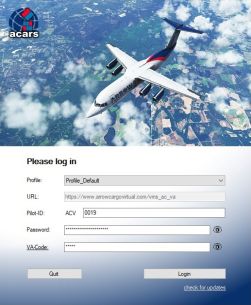
Wnd Login
The user can use ACVacars only after log in. Doing so, the following parameters are needed:
- Activated and not retired user-account on the website of ACV;
- Matching password;
- Matching VA-Code (pre-given by VA, if any).
The Wnd "Login" is shown during start-up of ACVacars if:
- Your VA-account is not (anymore) activated, is retired or has been deleted;
- The login parameters (Login, Password) of your ACVacars profile do not match the saved parameters of the relevant VA-account.
Wnd Main

Menu bar
Most entries are self explaining.
- E.g. the menu [Flight] containing important information about the running flight like loading-parameters and weather.
- The menu [Aircraft] gives an overview about the status of important aircraft parameters like the "light settings". Use this menu for cross-checking if ACVacars does detect specific settings (e.g. taxi-lights ON/OFF?) of the connected aircraft.
- To check for any ACVacars updates please click: [Help->Check for Updates].
- The menu [Admin] is only shown to ACV members with administration rights.
Sections
The window "Main" shows the most important telemetry data (section "Aircraft") and schedule/route data ("Flight") of the aircraft. The section "Route" presents the waypoints of the default route, which is optional to choose. Feel free to use your own route to fly from A to B.
Buttons

The buttons in the middle are for loading the bid/schedule into ACVacars and, after that, to start-logging the ACV flight. Make sure to select the respective flight on ACV website before loading it into ACVacars.
Press button "Start Log" to connect ACVacars with the flight simulation and to load the default values of the pre-flight into the loaded aircraft. See manual page "Logging a Flight" for more info about "how to" start-logging the pre-loaded flight.
After landing and parking at the arrival airport, press button "Finish Log" to end and to evaluate the flown flight. This step is required before being able to send the pirep data of the flown flight to the ACV website.
When ended and evaluated the flown flight, press button "Send Log" to send the temporary pirep data to your account on the ACV website. Do not forget this step! Else you may loose your temporary pirep data.
Log text

The second half of the Main window with the textbox contains the log text. Here are two sequences of text written. First sequence is the preparation text with details before start-logging the flight. After that, as second sequence, is the whole log-text being shown, protocolled during a flight.
Sequence 1 / after loading a bid/schedule, before reaching boarding-phase
Before start-logging an ACV flight, the log textbox shows helpful information for preparation of the linked flight simulation. The following content is listed in the log textbox:
- If and what flight simulation is running.
- If any and what ACV aircraft (-registrations) are being flown by other ACV pilots. It is not possible to fly ACV aircraft registrations which are flown by other ACV pilots at the moment of start-logging an ACV flight. An aircraft registration can be flown only once at the same time.
- The current loadout but changable data of the aircraft, existing in the running flight simulation.
- The default data of the existing aircraft, showing non-changeable boundaries (e.g. max-payload or empty-weight).
- Last but not least, the expected amount of payload (so called "available payload") to be transported during the next flight. And, by that, some pre-calculated parameters encalculating the predicted "available payload".
Sequence 2 / after start-logging the flight
After start-logging an ACV flight, the log textbox protocols the beginning parameters and relevant actions of the flying pilot (ACV member). Most relevant content:
- The beginning parameters containing helpful information for the last flight preparations.
- Protocols the different flight phases.
- Mentioning detected pilot errors [small(er)-pilot-errors, and NoGo-pilot-errors].
- Mentioning key achievements of a flight.
- Interim status-reports.

The footer contains basic information about ACVacars' program status and about the running flight:
- Curent time (UTC) of running flight simulation
- Time indications to different flight status. See shortcuts below Windows#Wnd Minimal.
- "Pen:" The sum in percent of all received penalties for pilot-errors during the ongoing ACV flight.
- FSUIPC / XPUIPC connection status
- ACV website account status, with data of logged-in ACV member
- Internet connection
Color legend: Green = ok/connected, Red = not available/not connected.
Start logging an ACV flight requires 1) green FSUIPC/XPUIPC and 2) green account and 3) green internet access indications.
Wnd Main / section [Aircraft]

The section “Aircraft” shows important aircraft data of the reserved and now chosen flight bid but also of the currently chosen aircraft inside your FSim. The most data are self-explaining. Of special interest are:
- “Th:” stands for “thrust” and indicates the current thrust in percent of your aircraft, flying with the connected FSim.
- A title showing e.g. “ACV A-300-600F N210LH” means the precise type of aircraft (“ACV A-300-600F”) including its registration number (“N210LH”) of the currently chosen flight bid. You can only start a flight when the matching aircraft type (including the correct registration number) is loaded inside your FSim.
- The label "Payload" shows the loaded payload on board of the aircraft. Click that label to gain more information about it and to enter the payload-manager of ACVacars. The forecolor markings do mean: "Green" = The available payload is fully or almost fully loaded to the current aircraft, "Black" = The available payload is clearly not fully but still with acceptable amount loaded to the aircraft, "Red" = Too less of the available payload is loaded to the aircraft OR the max-available-payload OR the overall max-payload has been exceeded. Warning: A flight shall never be started with a red marked payload label.
- The label "Fuel on Board" shows the loaded fuel-load on board of the aircraft. Click that label to gain more information about your FOB and to enter the fuel-load section of ACVacars' loadout manager. The forecolor markings do mean: "Green" = The FOB is close to the advised (estimated) fuel-load for the running flight, "Black" = the FOB is within meaningful boundaries to the estimated fuel-load, "Red" = the FOB is far away from the estimated fuel-load. Be aware, red color shall be taken as warning but not as final wisdom because in rare occasion even a red-marked fuel-load can be meaningful.
Wnd Main / sections [Flight & Route]

The section “Flight” shows the relevant data of the loaded flight bid. This section contains only meaningful data after loading a reserved bid from your webVA into ACVacars. Most data are self-explaining. Of special interest are:
- “Route-FL” indicates the recommended cruising altitude. Try to achieve and to hold this flight level for the most time you are at cruise level. Never reaching the pre-given “Route-FL” during a flight results in a penalty, it is expected to reach the indicated "Route-FL" at least once during an ACV flight. Be aware, the pre-calculated fuel-load estimation considers the pre-given Route-FL. The lower you cruise the less accurate is the pre-calculated fuel-load estimation.
- “Fuelload (estimated)” stands for the predicted needed fuelload to fulfil this flight. To refuel your aircraft with a lower amount of fuel could result in a range fail. To refuel with a higher amount of fuel could lead to an unwanted waste of not used payload.
- The section "Route" presents the waypoints of the default route, which is optional. Feel free to use your own route to fly from A to B. When section "route" is not showing any waypoints it does mean that no default route is existing.

section Flight, ICAO labels (green = installed, blue = place to be or to reach next) - A green colored departure / arrival ICAO label indicates that the user's local system has this airport as addon installed (checking custom addon-on folders for folder names containing the ICAO code). Clicking on that label opens all folders which are being checked by ACVacars for sub folders containing the ICAO code as folder name. A blue colored label indicates the place to be or to reach next.
Wnd Minimal

The button "Show Minimal" appears in the menu bar on main window of ACVacars after start-logging a new flight.
Click the menu-bar button "Show Minimal" on Main to open the semi-transparent Wnd Minimal.
The ACVacars main window is sent to system try of your OS task list during this process. It is not possible do show both windows (Wnd Minimal and Wnd Main) at the same time.
- Right-click to open this forum manual post.
- Double-click Wnd Minimal to return to Wnd Main.
- Drag & Drop Wnd Minimal with pressed mouse-button to place it at any wished location on your screen.
- Wnd Minimal is always placed on top of all windows, not only on top of your FSim.
Wnd Minimal shows some basic values (some also viewable in Main's footer), which are of special importance:
- "Th", stands for current percent of thrust (0% - 100%)
- "GW", stands for "gross-weight" (the sum of empty-weight + fuelload + payload)
- "GS", stands for ground speed (true airspeed plus wind speed)
- "TSc", stands for "Time Schedule" and indicates as sub-specifications: PB, TD or AR.
- "PB", means the moment of "push-back". But the event for measuring the moment of time is starting up the first engine.
- "TD", means the moment of "touch-down" on the runway of the arrival airport.
- "AR", means the moment of "arrival" at the destination gate, cargo- or parking position. But the event for measuring the moment of this is shutting down the last engine.
- "FT", stands for "flight time" which is currently predicted to reach the arrival airport at the present speed over ground (GS) following the entered waypoint route. (see also forum post: https://www.arrowcargovirtual.com/acvforum/index.php?topic=88.0)
- "Pen", stands for "penalty" and indicates the predicted reduction of the final flight time considering the until now happened penalized pilot mistakes/errors (e.g. having an engine running without beacon lights on). Best value is -0% meaning that the final flight time will not suffer any reductions. Worst value is -100% meaning that the complete final flight time value will not be accepted. The predicted reduction depends on the severeness of the happened pilot mistakes/errors.
- "ZFW", does mean "zero fuel weight", the sum of empty-weight plus payload.
- "Time accel.", appears in cases of time acceleration (2x and 4x possible in MSFS, P3D). Not possible to use X-Plane's time acceleration due to its dynamical decimal nivelation.
- "FPM", after touch-down at arrival destination, the Minimal shows also the "feet per minute" as information about the vertical touch-down speed.
Only during boarding-phase on ground,

the Minimal window shows further information about:
- Flight number
- Minimum to reach flight level once during flight
- SHOULD payload and IS payload
- Red colored: Warnings about exceedings of maxPayload, maxGW, rangeCG. Never taxi/take-off when red texted Minimal.
Only on ground and only for some specific aircraft,
the Minimal window shows additional buttons to indicate aircraft-triggers, like
- Parking Brake ON/OFF
- Autopilot ON/OFF
- Beacon Lights ON/OFF

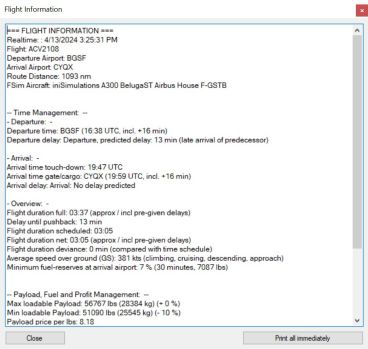
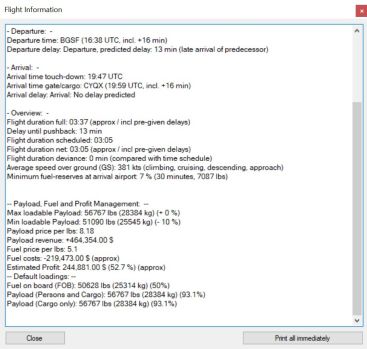
Wnd Flight Information
Clicking the Flight-menu entry "Flight Information" to reach it. The window Flight Information is only available while a running ACV flight.
This window gives information about important aspects of the loaded ACV flight. These information facilitate several decisions of your flight planning/settings during active boarding-phase. The flight information are structured as follows:
Structure
General indications
- Realtime at the beginning of your flight.
- Flight number
- Departure airport ICAO
- Arrival airport ICAO
- Route distance in nautical miles nm
- FSim aircraft (the truly flown one, not the scheduled aircraft in case of deviation)
Time Management
The following subsections give detailed information about important information of times considering the ongoing flight. Leading to a better understanding when your pushback time-slot is being expected, what planned arrival time and all known delay reasons if pre-given.
Departure
- Departure time, airport ICAO (if existing, the gate/cargo position)
- If any pre-given delay: The delay in minutes and its reason
- Pre-given delays are randomly generated and do not always occur. For increasing the simulation atmosphere.
Arrival
- Arrival time, airport ICAO (if existing, the gate/cargo position)
- If any pre-given delay: The delay in minutes and its reason
- Pre-given delays are randomly generated and do not always occur. For increasing the simulation atmosphere.
Overview
- Flight duration estimated, including any pre-given delays
- Predicted delay until pushback in minutes
- Scheduled flight time, without any pre-given delays
- Flight duration deviance (as result of any pre-given delay), compared with the scheduled flight time. Use this parameter as rough estimation, how to deal with your cost-index (CI) at cruise level.
- Average speed over ground (so called "ground speed" in knots) from take-off to touch-down.
- Minimum fuel reserves required while touching-down at arrival airport.
Payload, Fuel and Profit Management
This data part contains important information about payload, fuelload and profitability. Remember, it is not possible to load more payload than 100% of the "available payload" within the range of "aircraft's max payload" (see Payload Manager#Available Payload).
Default Loadings
- This fuelload (as weight lbs) indicates the estimated fuel required for the running flight.
- Payload (persons and cargo) indicates the recommended optimum how much payload in relation to how much fuelload should be loaded.
- Payload (cargo only) indicates the recommended payload without encalculated crew weight.
Key information values
Important key values for any flight are:
- Departure time, including any pre-given delays.
- Arrival time, including any pre-given delays.
- Minimum fuel-reserves at arrival airport, to make sure having at least 30min of fuel reserves while touch-down.
- Estimated profit, to check if your loadout configuration is within an acceptable range of profit (recommended 15-30%).

Wnd Weather Information
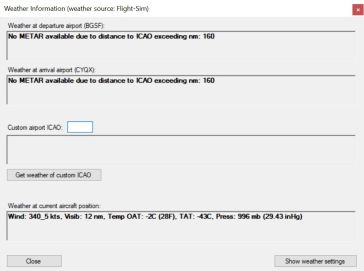
Open the Flight-menu and click on menu entry "Weather Information" to open the window Weather Information. The latter is only available during a running ACV flight. The weather data are taken of your running FSim or of a running ActiveSky instance (see Program Settings#Tab "Weather" for how to select the weather data source).
Attention: Each flight simulation has its own weather data limitation in conjunction with the FSUIPC/XPUIPC interface. Best works P3D with such interface. The receivable weather data may be limited in range or detail when requested from MSFS or X-Plane and even from P3D sometimes. If installed, it is recommended to use ActiveSky as weather source to avoid such data limitation while using P3D or X-Plane (actually, ActiveSky does not (yet) support MSFS). Without METAR source, the weather data of the flight simulation is shown as limited but more self-explaining string in ACVacars.
Weather at departure airport
If the running flight simulation is selected as only weather source, the FSUIPC/XPUIPC interface delivers the weather data at departure airport's location containing wind, visibility, temperature and air pressure. The weather data of the running flight simulation can only be gathered up to a distance of 160nm to your current aircraft position. The weather data is only shown as METAR if ActiveSky is linked as METAR source. Furthermore, no distance limitation exists if the METAR data is being read by ActiveSky.
Weather at arrival airport
If the running flight simulation is selected as only weather source, the FSUIPC/XPUIPC interface delivers the weather data at arrival airport's location containing wind, visibility, temperature and air pressure. The weather data of the running flight simulation can only be gathered up to a distance of 160nm to your current aircraft position. The weather data is only shown as METAR if ActiveSky is linked as METAR source. Furthermore, no distance limitation exists if the METAR data is being read by ActiveSky.
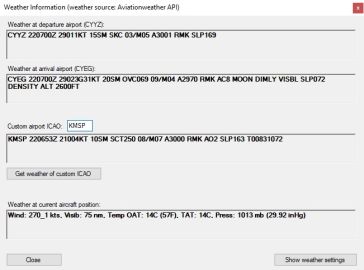
Custom airport ICAO
Enter any custom airport ICAO into the textbox to get its current METAR information. Without any linked external METAR source like ActiveSky, this option works at a distance up to 160nm around your current aircraft position, showing the weather data wind, visibility, temperature and air pressure. Without METAR source, the weather data of the flight simulation is shown as limited but more self-explaining string in ACVacars.
Weather at your current aircraft position
This textbox contains the weather data at your current aircraft position. Be aware, the wind data considers the wind at your aircraft location but at ground level. The same with the visibility. Only the temperature data and the air pressure data are matching the surroundings of your current aircraft altitude. These data are gathered via the FSUIPC/XPUIPC interface. For better readability, these weather data are not written in METAR format and contain only data about wind, visibility, temperature and air pressure.